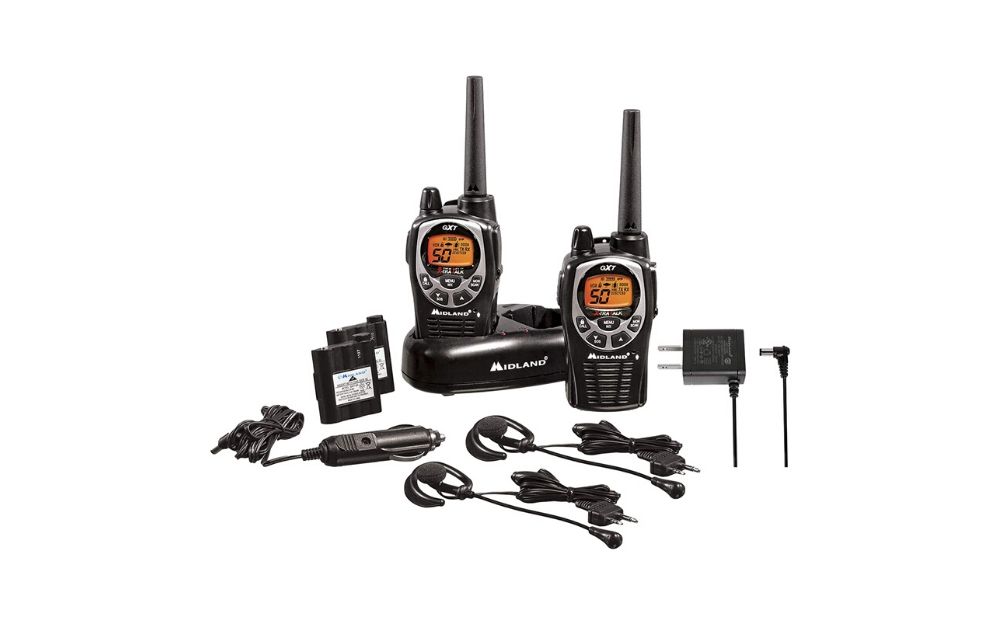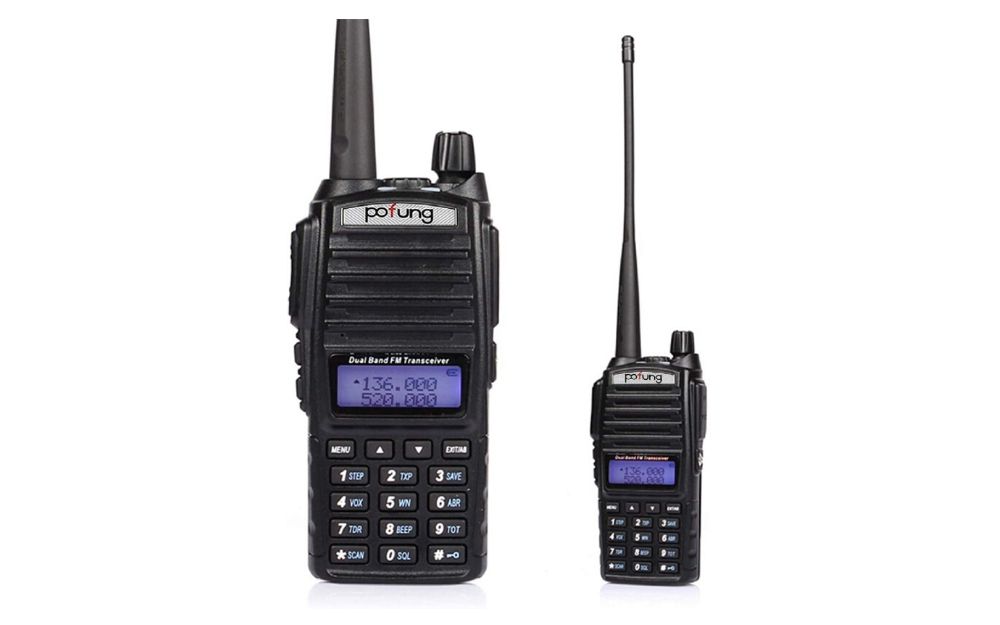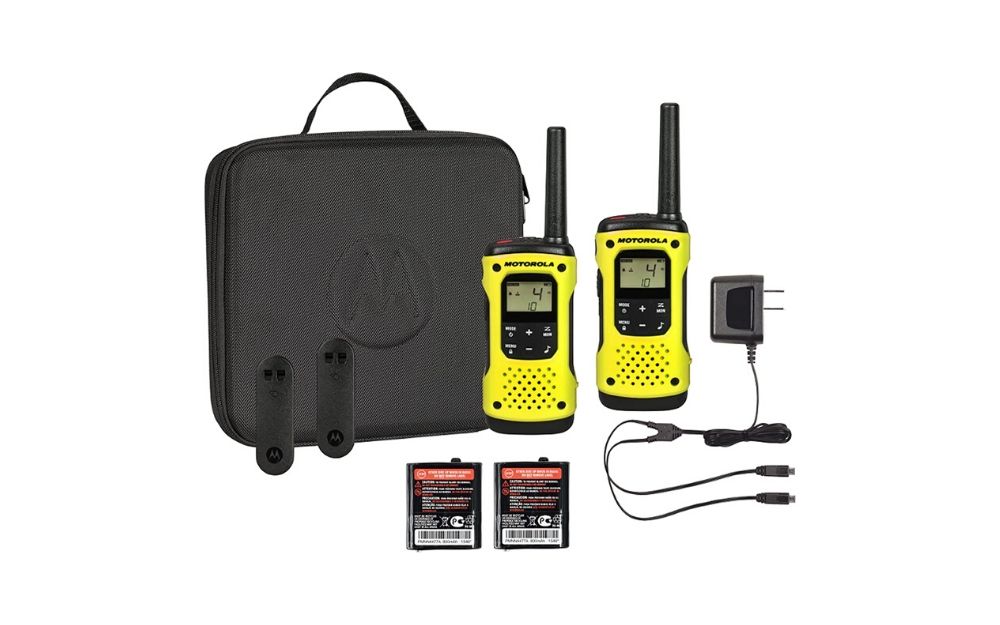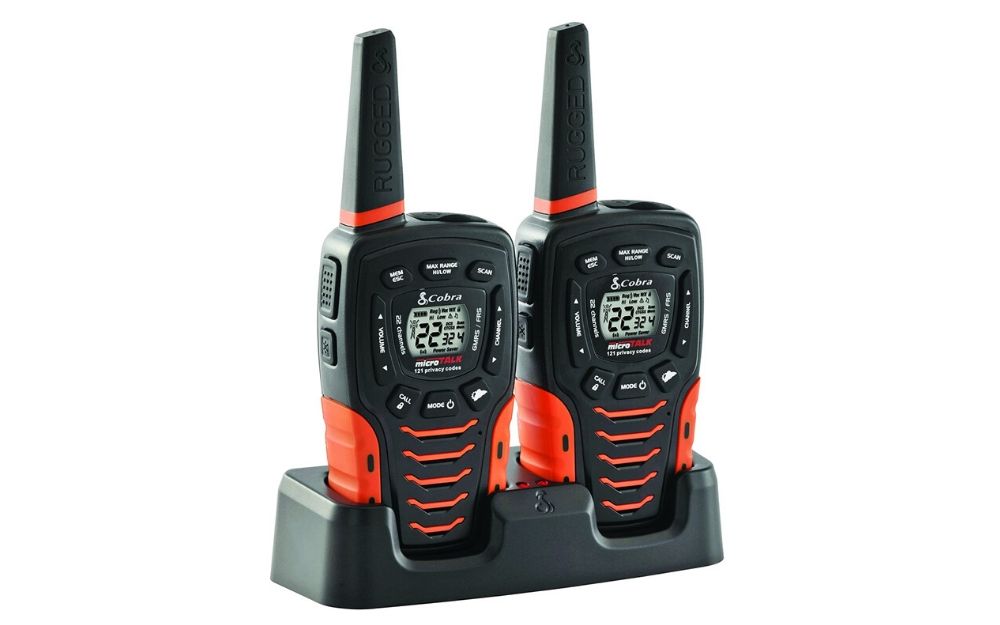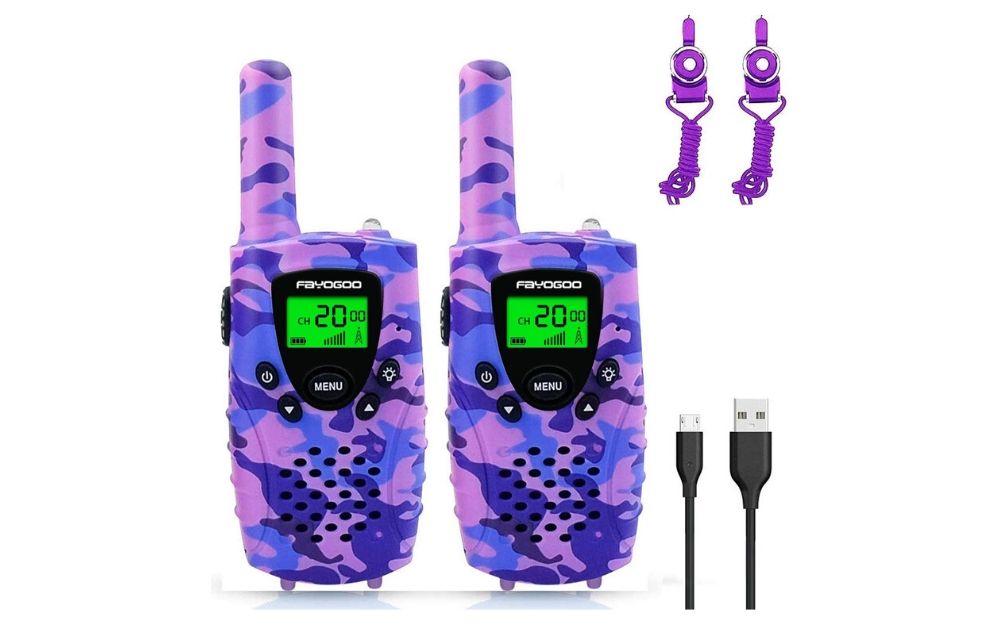If you’re going to venture into the great outdoors, you should always have a means for long-range communication. While a cell phone can be handy at times, signal reception isn’t always available, especially if you’re headed towards a remote locale.
Walkie-talkies, on the other hand, don’t rely on cell signals. These handheld radios are reliable in a pinch. If you’re looking to get one of your own, here are some of the best rated walkie talkies radios recommended by our veteran outdoorsmen.
Best Walkie Talkies
| # | PREVIEW | Product | |
|---|---|---|---|
| 1
Best Overall
1Midland GXT1000VP4 Walkie Talkie
|
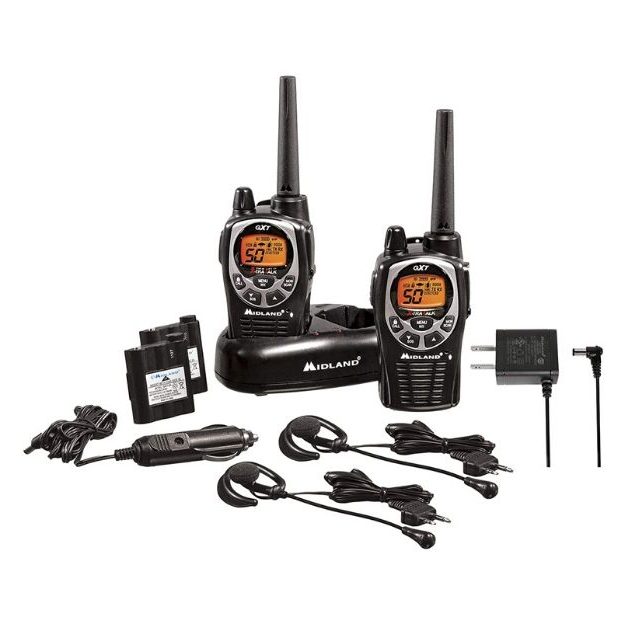
|
|
|
|
|
|||
| 2
Best For Low Budgets
2BaoFeng Pofung UV-82 Walkie Talkie
|
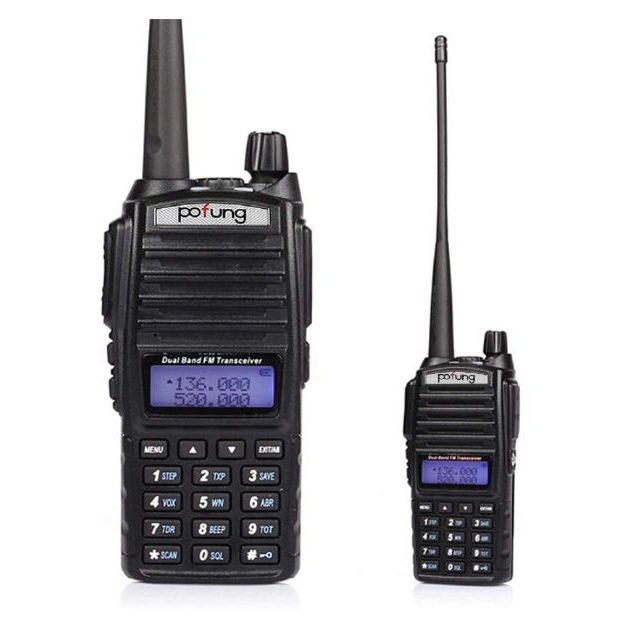
|
|
|
|
|
|||
| 3 |
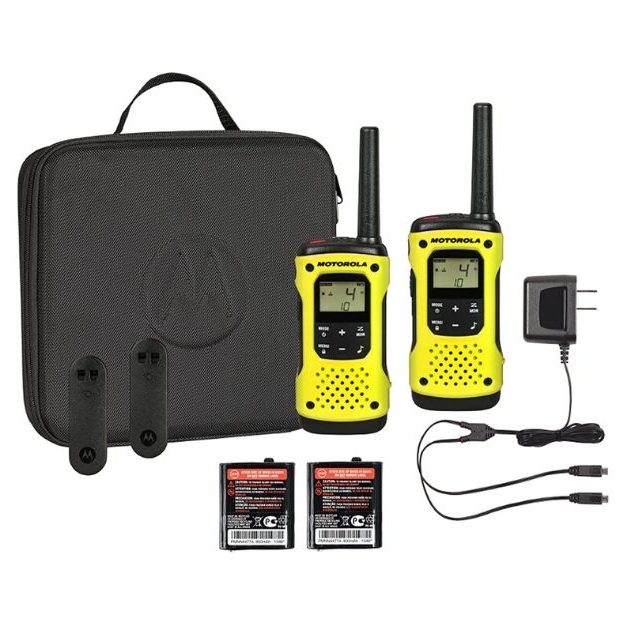
|
|
|
|
|
|||
| 4
Best For Higher Budgets
4Cobra ACXT645 Walkie Talkie
|
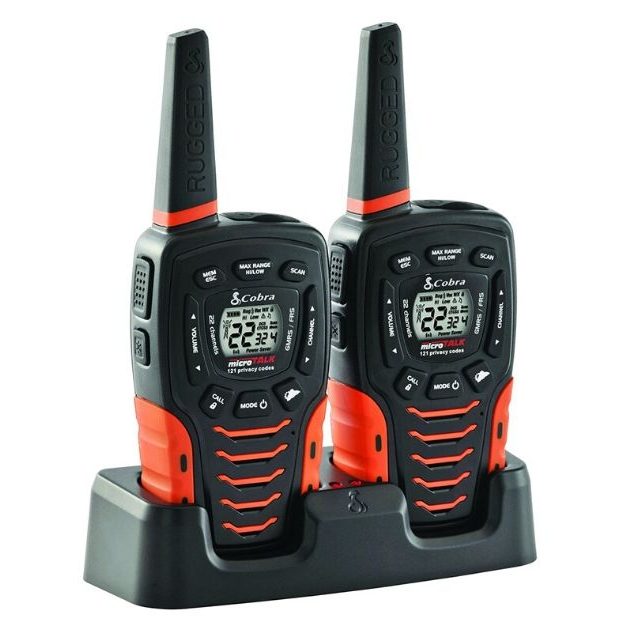
|
|
|
|
|
|||
| 5 |
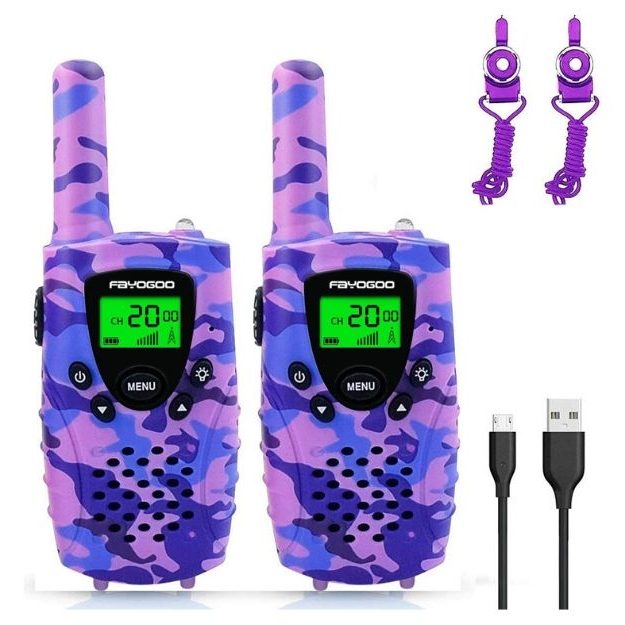
|
|
|
|
|
|||
1. Midland GXT1000VP4 Walkie Talkie
- NOAA Weather Scan
- Channel scan feature
- CTCSS/DCS privacy codes
The GTX1000VP4 is a good all-around walkie talkie with an impressive range. These radios can reach up to 36 miles when used at maximum power, which may be too much for general purposes, but can definitely come in handy during emergencies. Other features include NOAA weather scanning capabilities, a channel scanner, and over 140 different privacy codes.
This is a great tool to bring along when hunting with a partner or a small group. However, you may want to get a bigger battery or bring a few spares. The radio’s strong output heavily consumes battery power.
Specifications
Pros
- Great max range
- High channel security
- Convenient weather scanner
- Waterproof
Cons
- Not the best out-of-the-box battery
2. BaoFeng Pofung UV-82 Walkie Talkie
- Semi-duplex
- Independent A/B band operation
- VFO/Memory channel scan
- FM radio
The UV-82 takes the functionality of BaoFeng’s earlier two-way radio models and adds a few small twists to make a better device. This semi-duplex radio is capable of connecting to FM stations, has independent dual-band operation, and offers nine selectable VOX grades for clear communication. It has bigger buttons, a stronger speaker, and a more durable shell, compared to older BaoFeng radios.
It’s tough shell and hands-free operation makes it great for hunters who normally have their hands full or for hikers who go up treacherous paths. However,, it’s not waterproof, so you’ll need to be extra careful around puddles or bodies of water.
Specifications
Pros
- Versatile
- Comfortable to use
- Crisp speaker output
- Durable
Cons
- Not waterproof
3. Motorola T631 Walkie Talkie
- Built-in flashlight
- NOAA weather alerts
- Buoyant
- Dual power
The Motorola T631 walkie talkies are small, elegant, yet fully functional personal radios that are perfect for outdoor communications. Despite their size, they can reach out up to 35 miles in the right conditions, and they’re built to withstand almost every situation you may find yourself in when you’re out and about.
The T631 features a dual-power design, meaning it can use two different batteries: the usual NiMH battery packs and AA alkaline batteries. It is incredibly power efficient, and in case your NiMH packs run dry, you can use AA batteries, which are far more common than their larger counterparts.
Specifications
Pros
- Versatile
- High visibility
- Simple design
- Easy to use
Cons
- Can be confusing to use for beginners
4. Cobra ACXT645 Walkie Talkie
- Built-in flashlight
- Rubberized grips
- NOAA alerts
- PTT-enabled
The Cobra ACXT645 is designed for enhanced user survivability. It pairs high durability with excellent function, with its high range, maximum frequency compatibility, weather alert scanning capability, and even a built-in flashlight for low-light conditions. This walkie-talkie can tune into 22 FRS frequencies, as well as the standard GMRS ones, to allow for universal communication within a maximum range of 35 miles.
The device has a weather alert—a feature that shines best during stormy seasons. It also has rubberized grips that make holding the radio comfortable and secure. However, because of its limited microphone volume, you have to hold the radio closer to your mouth as you speak to make sure you’re heard loud and clear.
Specifications
Pros
- Durable
- Comfortable to use
- Convenient survival features
- Great range
Cons
- Microphone is somewhat weak
5. FAYOGOO Kids Walkie Talkie
- Simple, colorful design
- Multi-channel support
- Auto-squelch system
- Automatic channel scanning
These cool walkie talkies by FAYOGOO are the perfect radios for young children. While they aren’t heavy-duty, they’re great for short-range communication between family members. Whether you want to keep tabs on your kids while you’re out in the mall or if you’re looking for a fun way to call them down for dinner, this pair of talkies is a fantastic option.
It features full accessibility to FRS and GMRS channels, an auto-squelch system for crystal clear communications, and, in the right conditions, a respectable 4-mile range. It might not be ideal for trips up a mountain, but it can be useful during urban emergencies.
Specifications
Pros
- Plenty of quality-of-life features
- Very easy to use
- Sturdy
- Handy in emergencies
Cons
- Relatively short range
Walkie Talkie Buying Guide
Types
Walkie-Talkie for Kids
The type of walkie talkies that you get for your kids depends entirely on your intentions. There’s no harm in giving your kids a tactical walkie talkie, as long as they’re willing to learn (and you’re willing to teach) how to use them. But if you want to give them a more casual means of communication, you can opt to get children two-way radios that are specifically designed for them . They’re cheaper and easier to use.
Walkie-Talkie for Girls
A design for little girls actually has no actual impact on how walkie-talkies work. They’ll work the same way as any walkie talkie would. However, they do tend to have brighter and more colorful designs.
Long-Range Walkie-Talkies
It’s important to note that the actual range of walkie-talkies depend on many factors, like the current weather condition, your location, the surrounding terrain, your position above ground, and so on. Just because a long range walkie-talkie is advertised to be able to reach up to 30+ miles doesn’t mean that it will hit that mark consistently.
Rechargeable Walkie-Talkies
As the name suggests, these walkie-talkies use rechargeable battery packs instead of AA or AAA batteries. These have the benefit of cost efficiency, but such battery packs are also less common than their non-rechargeable counterparts.
Digital Walkie-Talkie
These types of walkie-talkie are functionally the same as analog radios, but the way they work is different. Digital walkie-talkies convert voices into streams before broadcasting them, which results in a much clearer voice quality compared to analog radios.
Satellite Walkie-Talkie
Some walkie-talkies are able to communicate with other walkie-talkies over a longer range via satellite. Most tactical walkie talkies and military-grade radios are able to use such satellites, as long as they are explicitly stated to be able to.
Style
Walkie-talkies come in different styles that have unique features.
Handheld Walkie-Talkies
All walkie-talkies are small and light enough to fit in your hand or to be strapped to your belt. These are simpler and more portable than ham radios and are perfect for mobile communications.
Hands Free Walkie-Talkie
Some walkie-talkies are equipped with a headset to allow for easier communication. Instead of having to put the actual radio close to your mouth, a headset will let you talk with other operators without detaching your radio from your belt.
Voice Activated Walkie-Talkie
You may have encountered a walkie-talkie with a “VOX” feature. VOX, or voice-activated exchange, allows operators to use walkie-talkies without having to press a button. VOX-enabled walkie-talkies will automatically detect when you’re talking and will broadcast your voice over your selected channel.
This is handy to use at times when you’re occupied with other things such as driving.
Applications
Here are some practical situations where a walkie-talkie can be very useful:
For Hiking
Mountain trails tend to have horrible cell signals. Your phone won’t be very useful for communicating when it can’t get a good signal going. Walkie-talkies for hiking, on the other hand, don’t rely on cell signals to work. You’ll be able to use them in case you get lost or get into an accident.
For Hunting
A hunting walkie talkie can be an essential tool for a successful hunt if you’re with a partner. Apart from the usual emergency applications, you’ll be able to cover more ground without losing contact. The device is great for letting your partner know if an area is clear, or if you come into contact with your hunting target.
For Cruise Ships
Cruise ships can be huge. Passengers, especially children, may get easily lost when aboard them. Getting a set of walkie-talkies for your family or group is a great way to stay connected with when you’re on a cruise trip.
For Skiing
Walkie-talkies are also very useful for communicating during skiing trips.
You’ll want to be able to keep tabs on everyone when you’re up a snowy mountain. To successfully do that, I recommend you to check our ski walkie talkies guide and choose the product that fits your criteria.
Also, be sure to choose a weather-resistant walkie-talkie, especially since the cold may cause some radios to malfunction.
For Business
You can use walkie-talkies to help run your business. They’re particularly helpful for events, deliveries, and other tasks that require a lot of coordination between people. Business walkie-talkies with an encryption feature also allows for secure, private communications.
For Security
Walkie-talkies are very common among security personnel across many commercial establishments, but you can also use them for home security. You can contact emergency channels in case of a home invasion, or you can call your neighbors for help when the need arises.
For Emergencies
Since they don’t rely on cell signals or fixed power sources, emergency radios are great for these instances. If an earthquake knocks down the local infrastructure, you’ll still be able to communicate and coordinate with emergency services and other nearby radio operators with little to no problems.
Commercial
Communication is essential for running a business, and walkie-talkies can fill in that gap. Their quick and portable nature make them very easy to use in mobile operations.
For Military
Military make extensive use of radios for secure and reliable communications. Encrypted radio channels are difficult to detect and long-range devices ensure proper coordination between units. Walkie-talkies are excellent tools for ground forces, helping them make sure that all of their movements are executed perfectly.
Features
Some walkie-talkies have certain features that make them objectively better than others. Here are a few features that you may want to keep an eye out for:
Waterproof Walkie Talkies
Waterproof walkie-talkies have industrial-grade waterproofing, making them perfect for trekking through wet environments or wading through floodwaters. Look out for IP or JIS ratings on a walkie-talkie if you’re looking for waterproof ones.
GPS
A GPS walkie talkie is able to provide operators with real-time updates on their locations, maxing out their visibility; perfect for venturing out into unknown territory or situations where you find yourself lost in the woods.
Encryption
An encrypted walkie talkie can provide users with secure lines of communications. These are best used in situations where privacy is key, such as military operations, where information can mean the difference between life and death.
Size
Not all walkie talkies have the same size. Though they are generally portable, there are some that are designed for even more mobility. Such walkie talkies have different advantages and disadvantages, however. Here’s a short overview on common walkie talkie sizes:
Small Walkie-Talkie
These are the most common of walkie-talkies. They come in sizes as small as 6” and weigh as light as 5 ounces. They can be a bit bulky, but they compensate for having space for bigger batteries. Bigger batteries typically have higher capacities, and larger walkie-talkies have stronger power outputs, giving a significant boost to range.
Mini Walkie Talkie
Mini walkie-talkies can be half the size of a standard walkie-talkie and about half as heavy. They’re great for maximizing mobility, and they can fit in your pocket. Smaller walkie-talkies sacrifice battery space and power output in favor of portability and convenience.
Walkie Talkie Range
Long-range walkie-talkies
The average long-range walkie-talkie can reach up to 36 miles under the most optimal of conditions. If you’re looking for a handheld radio that can reach extreme ranges, consider getting a handheld ham radio. These are typically stronger than walkie-talkies, but they also work a bit differently in terms of frequency range.
How does range work on walkie-talkies?
The effective range of a walkie-talkie depends on many factors. A walkie-talkie won’t always reach its maximum range.
Your immediate surroundings are one of the major factors to the effective range of your handheld radio. If you’re in an urban area with plenty of concrete walls and houses, expect your walkie-talkie’s range to be limited to just a few miles, as radio waves can’t go through all of the obstacles in its way.
The antenna you use is another major factor. A whip antenna is usually better at transmitting and receiving signals for handheld radios. The location of your antenna also drastically affects signal quality and thus, maximum range.
Your walkie-talkie’s power output will affect how far away it can transmit messages. The stronger the wattage, the farther the distance that the signal can reach.
Lastly, the type of signal you transmit will determine your overall range. As a rule of thumb, lower frequencies mean more range. VHF frequencies will be better than UHF frequencies, especially in wide open areas.
Pricing Range
While fancy features like GPS tracking, text messaging, and VOX-capability are nice, these aren’t always necessary. Sometimes, cheap walkie talkies are all you need.
There are walkie-talkies that are sold for around $20-60, depending on where you look. Despite their lower price range, most budget walkie-talkies are still quite decent, in terms of their transceiver performance and durability.
Frequently Asked Questions

Essentially, walkie-talkies are handheld radios. After tuning-in to a certain frequency, you’ll be able to send and receive messages to all users in that same frequency, as long as you’re within range.

Motorola walkie-talkies function in the same way other walkie-talkies do. Tune in to a frequency, hold the radio close to your face, press the designated PTT (push-to-talk) button, then speak clearly into the microphone. VOX-enabled walkie talkies will work even without pressing a PTT button.
The rest of the features, such as storing channels or configuring privacy codes, depend on what model of radio you’re using. Review the product manual for more accurate and detailed instructions on how to use a specific model.

The walkie-talkie was invented back in 1937.

The walkie-talkie was first made by Canadian inventor Donald Hings.

Walkie-talkies are available in most hobby stores, specifically the ones that sell hunting supplies. However, you can directly purchase walkie-talkies from Amazon and have them directly delivered to your doorstep instead.

You can take any USB charger and strip off one end to get to the wires. Attach the positive wire to your battery’s positive terminal and the negative wire to the negative terminal. Put some electrical tape on each end to keep them secure. Then, plug the USB charger into a power source and leave it for at least one hour.
Our Verdict
Walkie-talkies are very useful for emergency situations and short-range communication between groups of people. They aren’t as powerful as ham or station radios, but they can be very useful, particularly when you’re outdoors. Hikers, hunters, and other outdoorsmen can find great value from walkie-talkies, especially in places where cell phone reception is bad or completely unavailable.
If you’re going out into the wilderness or if you want to give your household an extra layer of security, getting a pair of walkie talkies can be helpful. Once you have your own set of radios, note down important frequencies, such as those of the local police station, the fire department, or the local group of radio enthusiasts, to make sure you have quick contacts when the need arises.

